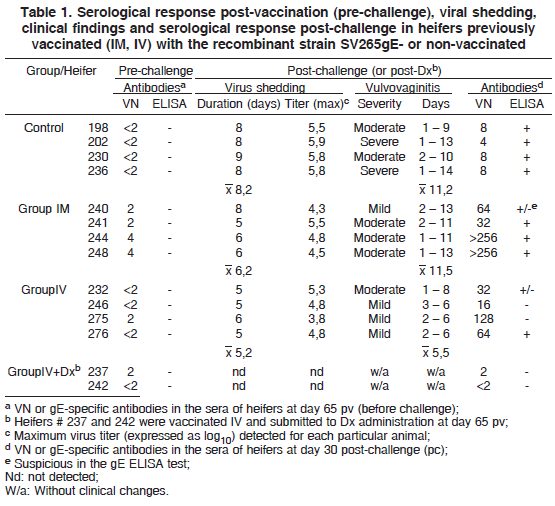Venereal infection of seronegative heifers and cows with bovine herpesvirus type 1.2 (BoHV-1.2) frequently results in vulvovaginitis and transient infertility. Parenteral immunization with inactivated or modified live BoHV-1 vaccines often fails in conferring protection upon genital challenge. We herein report an evaluation of the immune response and protection conferred by genital vaccination of heifers with a glycoprotein E-deleted recombinant virus (SV265gE-). A group of six seronegative heifers was vaccinated with SV265gE- (0,2mL containing 10(6.9)TCID50) in the vulva submucosa (group IV); four heifers were vaccinated intramuscularly (group IM, 1mL containing 10(7.6)TCID50) and four heifers remained as non-vaccinated controls. Heifers vaccinated IV developed mild, transient local edema and hyperemia and shed low amounts of virus for a few days after vaccination, yet a sentinel heifer maintained in close contact did not seroconvert. Attempts to reactivate the vaccine virus in two IV vaccinated heifers by intravenous administration of dexamethasone (0.5mg/kg) at day 70 pv failed since no virus shedding, recrudescence of genital signs or seroconversion were observed. At day 70 pv, all vaccinated and control heifers were challenged by genital inoculation of a highly virulent BoHV-1.2 isolate (SV56/90, 10(7.1)TCID50/animal). After challenge, virus shedding was detected in genital secretions of control animals for 8.2 days (8-9); in the IM group for 6.2 days (4-8 days) and during 5.2 days (5-6 days) in the IV group. Control non-vaccinated heifers developed moderate (2/4) or severe (2/4) vulvovaginitis lasting 9 to 13 days (x: 10.7 days). The disease was characterized by vulvar edema, vulvo-vestibular congestion, vesicles progressing to coalescence and erosions, fibrino-necrotic plaques and fibrinopurulent exudate. IM vaccinated heifers developed mild (1/3) or moderate (3/4) genital lesions, lasting 10 to 12 days (x: 10.7 days); and IV vaccinated heifers developed mild and transient vulvovaginitis (3/4) or mild to moderate genital lesions (1/4). In the IV group, the clinical signs lasted 4 to 8 days (x: 5.5 days). Clinical examination of the animals after challenge revealed that vaccination by both routes conferred some degree of protection, yet IV vaccination was clearly more effective in reducing the severity and duration of clinical disease. Furthermore, IV vaccination reduced the period of virus shedding in comparison with both groups. Taken together, these results demonstrate that SV265gE- is sufficiently attenuated upon IV vaccination in a low-titer dosis, is not readily reactivated after corticosteroid treatment and lastly, and more importantly, confers local protection upon challenge with a high titer of a virulent heterologous BoHV-1 isolate. Therefore, the use of this recombinant for genital immunization may be considered for prevention of BoHV-1-associated genital disease in the field.
Bovine herpesvirus; BoHV-1.2; vulvovaginitis; genital infection; latency; reactivation




